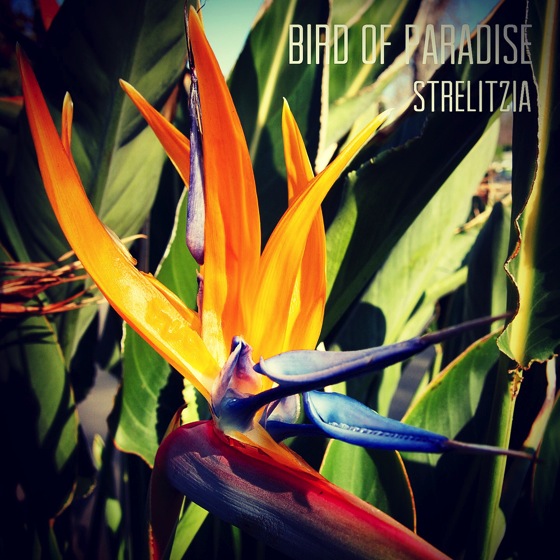Bird of Paradise (Strelitzia)
Another in what I classify as the “alien” plants that grow here in Southern California. They do look so other-worldly, exotic and fascinating. We see a lot of strelitzia in the landscapes here in the San Fernando Valley of Los Angeles, including a “giant” form that grows to the size of a tree.
Strelitzia /strɛˈlɪtsiə/[1] is a genus of five species of perennial plants, native to South Africa. It belongs to the plant family Strelitziaceae.[2] The genus is named after the duchy of Mecklenburg-Strelitz, birthplace of Queen Charlotte of the United Kingdom. A common name of the genus is bird of paradise flower / plant, because of a resemblance of its flowers to the bird of paradise. In South Africa it is commonly known as a crane flower and is featured on the reverse of the 50 cent coin. It is the Official Flower of the City of Los Angeles and two of the species, Strelitzia nicolaiand Strelitzia reginae are frequently grown as house plants. [3]
The species S. nicolai is the largest in the genus, reaching 10 m tall, with stately white and blue flowers;[4] the other species typically reach 2 to 3.5 m tall, except S. caudata which is a tree of a typically smaller size than S. nicolai. The leaves are large, 30–200 cm long and 10–80 cm broad, similar to a banana leaf in appearance but with a longer petiole, and arranged strictly in two ranks to form a fan-like crown of evergreen foliage. The flowers are produced in a horizontal inflorescence emerging from a stout spathe. They are pollinated by sunbirds, which use the spathe as a perch when visiting the flowers. The weight of the bird when standing on the spathe opens it to release the pollen onto the bird’s feet, which is then deposited on the next flower it visits. — Wikipedia
More information on Bird of Paradise (Strelitzia):
- Bird of Paradise (Strelitzia) on Wikipedia
- Bird of Paradise (Strelitzia) at Our House Plants
- Bird of Paradise (Strelitzia) at HousePlants.About.com
* A portion of each sale from Amazon.com directly supports our blogs
** Many of these books may be available from your local library. Check it out!
- Acanthus
- Agave americana
- Amaryllis
- Apricot (Prunus armeniaca)
- Aspen
- Azalea
- Banana
- Basil
- Bonsai
- Bougainvillea
- Brugmansia
- Butterfly (Lepidoptera)
- California Flannelbush (Fremontodendron californicum)
- California Poppy (Eschscholzia californica)
- Calla Lily (Zantedeschia aethiopica)
- Campsis radicans
- Castor Bean (Ricinus)
- Caltapa
- Chives (Allium schoenoprasum)
- Clematis
- Camellia
- Currant (Ribes)
- Dahlia
- Datura
- Japanese Cherry (Prunus serrulata)
- Daffodil (Narcissus)
- Dietes (Fortnight Lily)
- Dudleya
- Echinacea
- Ecualyptus
- Poinsettia (Euphorbia pulcherrima)
- Ficus benjamina
- Freesia
- Fungi
- Geranium
- Gerbera Daisy
- Grape (Vitis vinifera)
- Helianthus (sunflower)
- Hibiscus (Malvaceae)
- Honeybee
- Iris
- Jacaranda mimosifolia
- Joshua Tree (Yucca brevifolia)
- Kniphofia “Red Hot Poker”
- Lantana
- Lavender (Lavendula)
- Kousa Dogwood (Cornus kousa)
- Magnolia x soulangeana (Saucer Magnolia/Tulip Tree)
- Mandevilla
- Magnolia Grandiflora
- Marigold (Calendula officinalis)
- Matilija Poppy (Romneya)
- Morning Glory (Convolvulaceae)
- Nandina
- Oleander (Nerium)
- Olive
- Orange
- Orchid from the Southern California Spring Garden Show 2013
- Oriental Poppy (Papaver orientale)
- Polygonatum (Solomon’s Seal)
- Paperwhites
- Pineapple (Ananas comosus)
- Primula (Primrose)
- Queen Anne’s Lace (Daucus carota)
- Rosa ‘JFK’
- Rosa ‘Mikado’
- Rudbeckia
- Salvia
- Squirrel
- Star Jasmine (Trachelospermum jasminoides)
- Succulents
- California Sycamore (Platanus racemosa)
- Sweet Potato (Ipomoea batatas)
- Tomato
- Vinca
- Water Lily (Nymphaeaceae)
- Wisteria
- Zinnia










